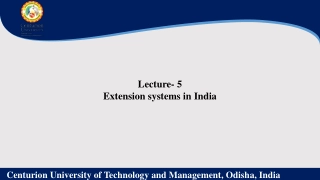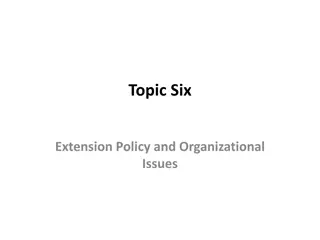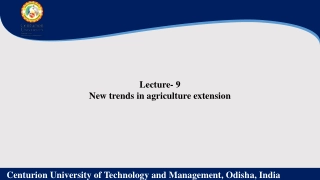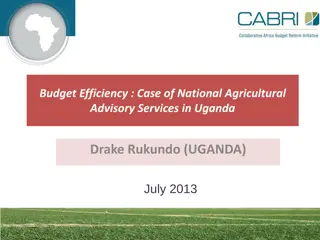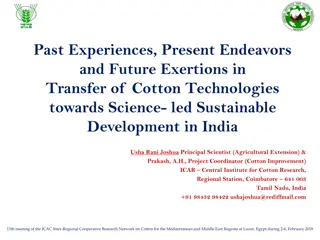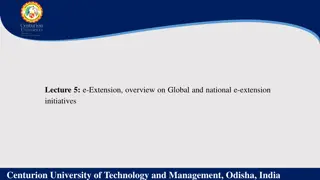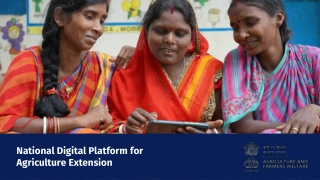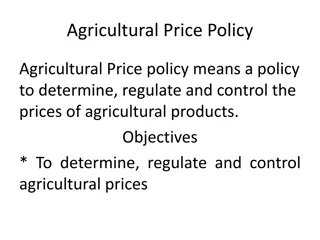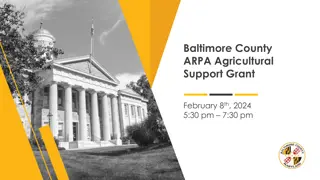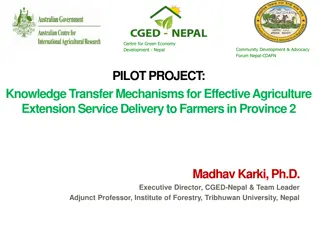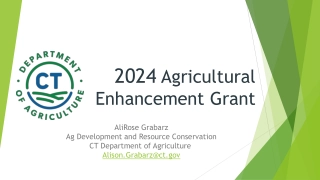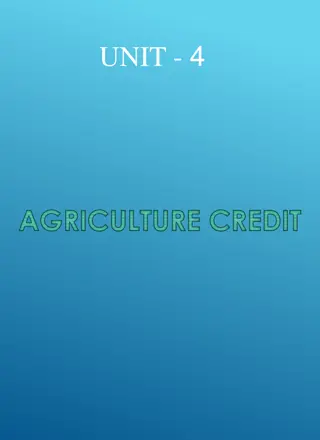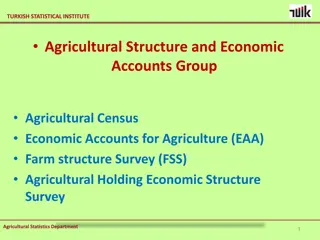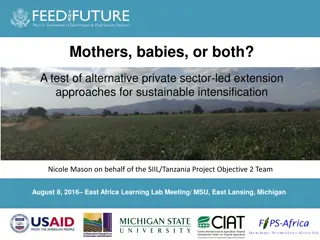Evolution of Agricultural Extension Services in India
Agricultural extension in India has evolved through four generations, from colonial agriculture to diverse top-down and unified top-down extension approaches. The system has adapted to meet the needs of the farming community, with a focus on scientific research, knowledge application, and farmer education. Post-independence, organized extension activities were initiated by the government. The development of extension services has progressed through various stages, reflecting the changing agricultural landscape in India.
Download Presentation

Please find below an Image/Link to download the presentation.
The content on the website is provided AS IS for your information and personal use only. It may not be sold, licensed, or shared on other websites without obtaining consent from the author. Download presentation by click this link. If you encounter any issues during the download, it is possible that the publisher has removed the file from their server.
E N D
Presentation Transcript
WELCOME TO 2 SEMINAR WELCOME TO 2ND SEMINAR ND
Privatization of agricultural extension Privatization of agricultural extension services in India: Approaches and case services in India: Approaches and case studies studies http://upload.wikimedia.org/wikipedia/commons/9/97/Bartlett_-_Extension_Meeting_-_Laos%282006%29.jpg NAVEEN KUMAR P Ph. D. Scholar PALB-4021
INTRODUCTION INTRODUCTION Agricultural extension is a general term meaning the application of scientific research and new knowledge to agricultural practices through farmer education The term extension was first used to describe adult education programs in England in the second half of the 19th century
Based on pre-independence experiences of the early extension efforts, systematic, planned and country-wide extension system passed through various stages to meet the needs of farming community Immediately after the independence, organised extension activities were undertaken by the government through initiation of community development programme and others
Four generations of extension in India Four generations of extension in India The development of extension services has differed from country to country. Despite the variations, it is possible to identify a general sequence of four periods or 'generation Colonial agriculture Diverse top-down extension Unified top-down extension Diverse bottom-up extension
Colonial agriculture Experimental stations were established in a country by the colonial powers The focus of attention was usually on export crops such as rubber, tea, cotton and sugar Technical advice was provided to plantation managers and large landowners Assistance to small farmers who grew subsistence crops was rare, except in times of crisis
Diverse top-down extension After independence, commodity-based extension services emerged from the part of the colonial system, with production targets established as part of five-year development plans In addition, various schemes were initiated to meet the needs of small farmers, with support from foreign donors IADP, IAAP ,ICDP ,HYVP etc
Unified top-down extension During the 1970s and 1980's, the Training and Visit system (T&V) was introduced by the World Bank Existing organizations were merged into a single national service Regular messages were delivered to groups of farmers, promoting the adoption of "Green Revolution" technologies The delivery of public extension services is based on a supply driven, top down approach rather than a demand driven approach
Diverse bottom-up extension When World Bank funding came to an end, the T&V system collapsed in many countries, leaving behind a patchwork of programs and projects funded from various other sources The decline of central planning, combined with a growing concern for sustainability and equity, has resulted in participatory methods gradually approaches replacing top-down The delivery of private extension services is based on a demand driven, bottom-up approach Therefore private extension supplementary or alternative to public extension services
Objectives To know the concept of private Extension To know the important private extension service providers in India To understand the private extension approaches which could be tried in India To review the case studies related to private extension
Concept of Private Extension Concept of Private Extension It involves personnel in the private sector that delivers advisory services in the area of agriculture and is seen as an alternative to public extension Services rendered in the area of agriculture and allied aspects by extension personnel working in private agencies or organizations for which farmers are expected to pay a fee and it can be viewed as supplementary or alternative to public extension services - Saravanan and Shivalinge Gowda (1999)
Reasons Behind the Privatization Issue The most important reasons behind the issue of privatization of extension system are To reduce financial burden : Declining trend in government expenditure for on government extension Disappointing of public extension service performance :Ineffective extension work Non viable transfer of technologies Unmatching with farmers needs Bureaucratic nature of extension workers No accountability to farmer Low extension system coverage of public : In terms of both time and services Wide extension worker : farmer ratio in India :1:1000 extension worker to farmer ratio 25 percent of extension workers - administrators An extension worker attends office for about 250days in a year 50 percent time goes for administrative work
Commercialization of agriculture : Shifting of agriculture from subsistence to commercialised agribusiness Globalisation and liberalization era demand for effective alternative extension approach To reduce marketing problems : Farmers are facing lot of marketing problems Specialised nature of agriculture demands quick and technically sound marketing information
Assumptions Behind Private Extension Generates new income, extension become economic input Provides Demand-Driven Service Increases the voice of farmers in the extension service More cost effective with efficient and quality service Extension personnel become more client accountable Increases staff professionalism Clients (farmers) are more committed to the service Don t concentrate on food grain production
Expected Elements in the Private Extension System Expected Elements in the Private Extension System Objectives Profit maximization Efficiency Target group Only those who can pay (commercial, big farmers) More committed Highly careful Active participation Offerings: Technologies Location specific Demand driven Profitable Input supply Timely Organization Private consultancy Commercial, agro-based firms Input agencies Farmer s organizations etc.
Extension personnel Accountable to farmers Highly motivated High professionalism Funding Clients contribution Development agencies Extension service Advisory in nature Economic input, generates new income Methods Personal communication Low with group and mass communication
Important private extension service providers Important private extension service providers Input agencies (dealing with seeds, fertilisers, pesticides, equipments) Large agri-business firms (involved in manufacture and sale of inputs and purchase of farm produce) Farmer organisations and producer co-operatives Non-governmental organisations (NGOs) Media (print, radio and television) Financial agencies involved in rural credit delivery, and Consultancy services
Input agency extension About 2.82 lakh agro-input dealers are operating in rural areas covering all parts of the country Though not equipped with adequate knowledge, dealers are one of the most important sources of information for farmers Many agro-input companies perform some extension functions A few of them also take up few demonstrations to publicize new products Meetings or seminars organised by line departments such as DoA Major categories of agro-input companies include, those dealing with seeds, fertilisers, pesticides and agro-machinery
Agri-business firms (aggregators, processors) Major agri-business firms like ITC and Pepsi co during the last few years have initiated innovative arrangements to provide farmers with integrated production and marketing support ITC s extension effort revolves around e-chaupals, which are essentially village internet kiosks that enable access to information on weather, market prices and scientific practices PepsiCo was a pioneer in the concept of contract farming under which the company transfers agricultural best practices and technology and procures the produce at a guaranteed price
Farmer organisations and producer co-operatives User groups, including farmer interest groups, farmer clubs, commodity groups, women farmer groups, special interest groups etc play a very important role in extension Government is also keen on promoting farmer organizations as it could create mechanism at the village level among farmer members to empower them for their own problem solving One of the oldest and most successful farmer organisations in India is the Grape Growers Association of Maharashtra which provides a wide range of services to its member producers
Non-Governmental (voluntary) organisations (NGOs) NGOs active in rural development in India range from fewer than 10,000 to several hundred thousand depending on the type of classification used 15,000-20,000 are actively engaged in rural development India has a number of NGOs with varying levels of capacity, implementing a wide range of programmes NGOs receive funding from the Government, corporate bodies as well as international donors Bharatiya Agro-Industries Federation (BAIF), Professional Assistance for Development Action (PRADAN) and Action for Food Production (AFPRO)
Media and Information Technology The widespread availability and convergence of information and communication technologies (ICTs) computers, digital networks, telecommunication, television etc Private TV channels like E-TV started telecasting daily programmes on agriculture. E-TV currently telecast agricultural programmes in Telegu, Kannada and Marathi languages every day Similarly most of the private regional TV channels telecast agricultural programmes at least once a week
Community Radio (CR) is another innovation in use of media and it is a short range radio station that caters to the information needs of communities living in surrounding areas Newspapers and farm magazines are important sources of information for farmers Newspapers, especially those in local languages, provide at least one page every week for news and articles on different aspects of agriculture
Financial Institutions Financial institutions lending to agricultural sector provide advice and consultancy to potential borrowers on financial viability of their proposals All banks involved in agricultural lending organises farmer meetings and seminars every year Banks also lend limited financial assistance to other organisations or state Department of Agriculture for organising agricultural seminars and farmer meetings NABARD has been supporting the establishment of farmer clubs. Farmers Clubs are grassroot level informal forums of farmers The broad objective of setting up Farmers Clubs is to achieve prosperity for the farmers with overall agricultural development in its area of operation
Consultancy Farmers generally consult progressive farmers for information and advice related to production, post harvest management and marketing Another major source of advice is the local input dealer Some input firms such as AGROCEL and Tata Kisan Kendras provide free consultancy services Many professionals after retirement from agricultural research organizations have been providing consultancy to farmers At present big farmers, farmers growing commercial crops like coffee, tea, spices, flowers, grapes, pomegranate etc and those having large poultry units and dairy farms are availing consultancy services
Para technicians (those without professional degrees but trained in specific skills) do provide services for a fee in the area of artificial insemination, grafting, etc and charge for the service Similarly para extension workers promoted by DoA in states such as UP, Rajasthan and Madhya Pradesh also provide limited extension services (message delivery and training) to fellow farmers in his/her village
Private Extension in India -SWOT analysis Strengths Strengths: : Efficiency of delivery channels and economic efficiency More demand driven High quality of services Trained manpower, sustained finances and resource allocation Closeness to markets. E.g.: input companies Better linkages with research Improved agricultural productivity and Standards of living Flexible in program implementation and practical in approach
Weaknesses Weaknesses More face-to-face contacts and less emphasis on mass media Increased dependence of farmers and hence exploitation Payments cannot be deferred nor based on impact; and extension becomes an economic input Contradictory message flows from competing sources due to advertisements and publicity techniques Human resource and organizational development are sidelined Group formation will be totally missing in this process
Opportunities Opportunities Support and control by clients leading to client orientation. Since farmers are paying money, they shall have the right to exercise and draw services Availability of specialized services to specific clientele groups Employment opportunities opened up due to more requirement of manpower More export oriented due to more concentration on crops earning valuable foreign exchange Increased accountability and commitment of Extension Personnel due to job demands and compulsion
Threats Threats: : Possible risk of marginalization of small farmers-an advent of more pay - more receive philosophy Market failure due to unauthentic multiplication of agencies providing products with no emphasis on quality. Obviously, a case of unhealthy competition. E g: Seed companies Social development of the people takes a backstage due to profit motto of the actors
Private Extension approaches which could be Private Extension approaches which could be tried in India tried in India Share cropping system Extension contract system Village extension contract system Contract farming Public extension through private delivery
Share cropping system The extension worker provides advisory and inputs Farmer uses his land and labour Extension worker share the crop with farmer for a profit Hired labour and other costs are shared The extension workers using his link easily obtain farm inputs from input dealers even for credit until the harvest Share cropped field serves as a demonstration plot. Since, extension worker has a personal stake, it motivates him to put maximum effort Extension worker can also enter into agreement with as many farmers as he can, depending on his financial position and time
Extension contract system Agricultural consultant / firm will provide advisory and inputs to individual farmer or group The cost of input is recovered after the harvest The extension worker / firm is compensated by the farmer with some percent of the value of the crop above the agreed target If the harvest falls below the agreed target as a result of poor technical recommendations or non-supply of timely inputs, the compensation amount will be proportionately reduced
Village extension contract system An agricultural advisory committee consisting of representatives of farmers at village level hire consultancy Even Panchayat can undertake similar role. Consultant work for the village as per the requirements of village, as mutually decided by committee and consultant The committee collect money from villagers based on some criteria like area / crop and pay for consultancy Here, consultancy is a group approach where as for specific visits farmer has to pay
Contract farming The agri-business firm provides all inputs and technology It also supervises production process Farmer has to sell his product, as quality specified to the firm only, for a premium price The firm process and sell the product Here the farmer gets input, technology and market support The firm gets quality products at reasonable price by eliminating the middlemen
Public extension through private delivery Agricultural consultancy firms are graded and certified by a government agency Depending on PESP capacity, extension services are awarded to competitive bidders at different levels i.e. state, district, block / village Panchayat The service cost is shared between government and clients i.e. Farmers in different proportions If the clients are not happy about the service, the consultancy firm will be replaced by others
Criticism against privatization of extension The major drawback pointed out in private extension is the lack of human face and exploitation of marginal farmers Small and marginal farmers who take up production of cereals and pulse crops are likely to be totally neglected Privatization is bound to neglect less profitable crops Privatization may not care for sustainability
Conceptual Framework Depicting a Public, Private and NGO Partnership
An analysis of public and private agricultural extension services in Balochistan, Pakistan -Mengal, A. A., 2012
Comprehensive study on private extension service availing farmers in Tarai region of Uttarakhand Itigi Prabhakar, et al., (2011)
Objective To find out the activities provide by the PESP s Methodology Study area : Tarai region of Uttarakhand Research design: Analytical research design Sample size n= 60
Table1: sources of various services used by respondents n=60 Sl. no Sources SDA PESPs Agri. Co.operatives Services Univ./KVK f 18 f % f % % f % 1 Planting material Fertilizers 23 38.33 19 31.66 30.00 00 00.00 2 06 10.00 28 46.66 00 00.00 26 43.33 3 Cultivation practices Plant protection measures Marketing information Soil testing 13 21.66 28 46.66 19 31.66 00 00.00 4 02 03.33 43 71.66 15 25.00 00 00.00 5 19 31.66 41 68.33 00 00.00 00 00.00 6 24 40.00 19 31.66 17 28.33 00 00.00 7 veterinary services 45 75.00 00 00.00 15 25.00 00 00.00
Table.2 Relative importance of information as perceived by respondents. n=60 Weighed mean score Sl. no Type of information Rank Level 1 Planting material 3.32 I Extremely important 2 Cultivation practices 3.20 II Extremely important 3 Fertilizers 3.18 III Extremely important 4 Plant protection measures 3.05 IV Extremely important 5 Veterinary services 2.82 V Very important 6 Soil testing 2.77 VI Very important 7 Marketing information 2.58 VII Very important 8 Packaging information 2.20 VIII Very important 9 Farmers training 1.88 IX Important 10 Harvesting technique 1.42 X Important 11 Post harvest processing information 1.12 XI Important
Private Extension in Ginger: A successful Story in Telangana Private sector efforts can play an important role in case of high value commodities, specialty products, technology intensive production methods, new crops and commodities Focus is an innovative private extension service model in ginger in Medak district of Telangana State which may be rated as resource poor area Sasikumar, 2016
Background Mr. Sashikant Patil and Mr. Anil Kumar Bajpai Mr. Sashikanth Patil is a progressive farmer as well as active political leader Mr. Bajpai - Agricultural professional with more than 15 years of experience in agricultural marketing Sugarcane -farm economy of Medak district; 2007-08: more area Production led to low price Mr. Patil (Chairman of CDC) crop diversification-logical solution Visited a private seed firm in Chhattisgarh on a mission to learn about improved technologies in agriculture Ginger farmers getting much higher yield & profit in Chhattisgarh Mr. Patil did not miss the chance for a creative intervention in ginger cultivation in Medak Sasikumar, 2016


